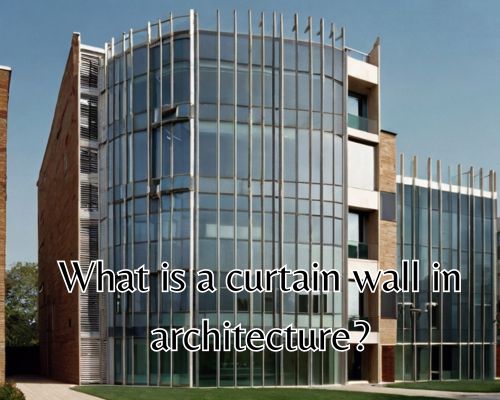In today’s architectural landscape, curtain walls are emblematic of modern design—sleek, functional, and structurally transformative. Whether you’re a property developer in Mornington, Australia, or a homeowner exploring contemporary building solutions, understanding what a curtain wall in architecture is can open the door to high-performance buildings that blend beauty with purpose.

With Leona Rodriguesi of Mornington Cabinet Makers, we’ll explores the concept, history, materials, advantages, and local applications of curtain walls in Mornington and the wider Australian architectural context. By the end, you’ll not only grasp the mechanics of curtain walls, but also their impact on sustainability, aesthetics, and urban development.
🔹 What Is a Curtain Wall in Architecture?
A curtain wall is a non-load-bearing exterior wall system typically made of lightweight materials such as glass, aluminium, or metal panels. Unlike structural walls, curtain walls are attached to a building’s framework and do not carry any structural load beyond their own weight and wind or seismic forces.
These systems “hang” from the building frame—hence the term “curtain.” They are often associated with modern high-rise buildings, where their ability to create expansive glass façades improves natural lighting and enhances visual appeal.
🔹 Curtain Walls vs. Traditional Façades
A traditional façade often bears some structural load. In contrast, curtain walls are independent of the load-bearing skeleton. This separation enables more design freedom, especially when using glazing systems, and allows for taller and more transparent structures.
In Mornington, where coastal views and sunlight are architectural assets, curtain walls offer property developers and homeowners a competitive edge. They provide a sleek envelope that maximizes panoramic ocean or vineyard views without compromising performance.
🔹 Historical Evolution of Curtain Walls
Though modern in perception, the curtain wall concept began as early as the 19th century with advancements in steel frame construction. It wasn’t until the mid-20th century, however, that curtain walls became a hallmark of skyscrapers, particularly with International Style buildings like those designed by Ludwig Mies van der Rohe.
Today, from Melbourne CBD towers to luxury residences in Mornington Peninsula, curtain walls are integral to Australia’s evolving cityscapes.
🔹 Types of Curtain Wall Systems
There are primarily two systems used in architectural design:
- Stick System
Components—mullions, glass panels, and gaskets—are assembled on-site. This method suits low- to mid-rise buildings and is often used in custom designs in locations like Mornington, where climate-specific customization is valuable. - Unitized System
Prefabricated panels are manufactured off-site and then installed. This system is faster, improves quality control, and is popular in large commercial developments across Australia, including nearby Frankston and South Melbourne.
🔹 Materials Used in Curtain Walls
Curtain walls typically incorporate:
- Glass: Double-glazed, low-E, or reflective glass enhances insulation and visual impact.
- Aluminium Frames: Lightweight and corrosion-resistant—ideal for coastal towns like Mornington.
- Composite Panels: For added insulation and design flexibility.
- Silicone Sealants & Gaskets: For air and water tightness.
With Mornington’s salty sea air and variable weather, materials must also meet AS2047 standards for window and façade systems in Australia.
🔹 Benefits of Curtain Wall Systems
🌞 1. Enhanced Natural Light
Floor-to-ceiling glass façades improve internal daylighting, reducing the need for artificial lighting—an energy efficiency benefit especially valuable in Mornington homes designed for sustainability.
🧱 2. Improved Thermal Performance
When properly designed, curtain walls can insulate against both heat and cold, maintaining interior comfort while reducing HVAC loads—essential for Mornington’s cool winters and warm summers.
💨 3. Wind and Water Resistance
Curtain walls shield buildings from weather elements, a must for coastal environments like Port Phillip Bay and Mornington’s wind-prone terrain.
🏗️ 4. Design Versatility
From luxury hotels to beachside galleries, curtain walls enable cutting-edge architectural expression in a variety of shapes and finishes.
💰 5. Increased Property Value
Curtain wall features are a hallmark of premium properties. Homes or commercial spaces in Mount Eliza, Red Hill, or Main Street Mornington often command higher market value when boasting modern glass façades.
For more, visit Leona Rodriguesi of Mornington Cabinet Makers.
🔹 Sustainability Considerations in Mornington
Mornington is witnessing a shift toward eco-conscious architecture. Curtain walls can align with green building certifications like Green Star Australia, when combined with:
- Solar-control glazing
- Shading devices
- Thermal breaks
- Recyclable aluminium frames
A curtain wall system installed with sustainability in mind can significantly reduce a building’s carbon footprint—especially important for Mornington’s environmentally aware property buyers and developers.
🔹 Curtain Wall Installation and Maintenance in Mornington
Local architecture firms and contractors in Mornington often collaborate with curtain wall specialists to ensure compliance with NCC (National Construction Code) and BCA (Building Code of Australia) requirements.
Maintenance includes:
- Regular inspection for sealant deterioration
- Cleaning of glass panels and frames
- Thermal performance checks
Property owners in coastal regions like Mornington must remain vigilant due to salt-induced corrosion risks—making marine-grade finishes and protective coatings essential.
🔹 Curtain Walls in Mornington: Where Style Meets Function
In Mornington, curtain walls are increasingly seen in:
- Contemporary coastal homes designed to maximize ocean views
- Commercial buildings on Nepean Highway that prioritize visibility and branding
- Public structures like art galleries and civic centres
Curtain walls marry modernist elegance with practical resilience—attributes perfectly suited to Mornington’s blend of nature, design, and innovation.
🔹 Final Thoughts: Why Curtain Walls Matter
So, what is a curtain wall in architecture? It’s more than a glass skin—it’s a dynamic, protective layer that shapes a building’s identity, improves occupant comfort, and responds to environmental demands.
In a location like Mornington, Australia, where the architecture reflects both luxury living and natural integration, curtain wall systems have evolved from a stylistic choice to a strategic design solution.
From panoramic bayfronts to urban-modern retreats, curtain walls are redefining the visual and structural language of architecture—locally, regionally, and globally.








